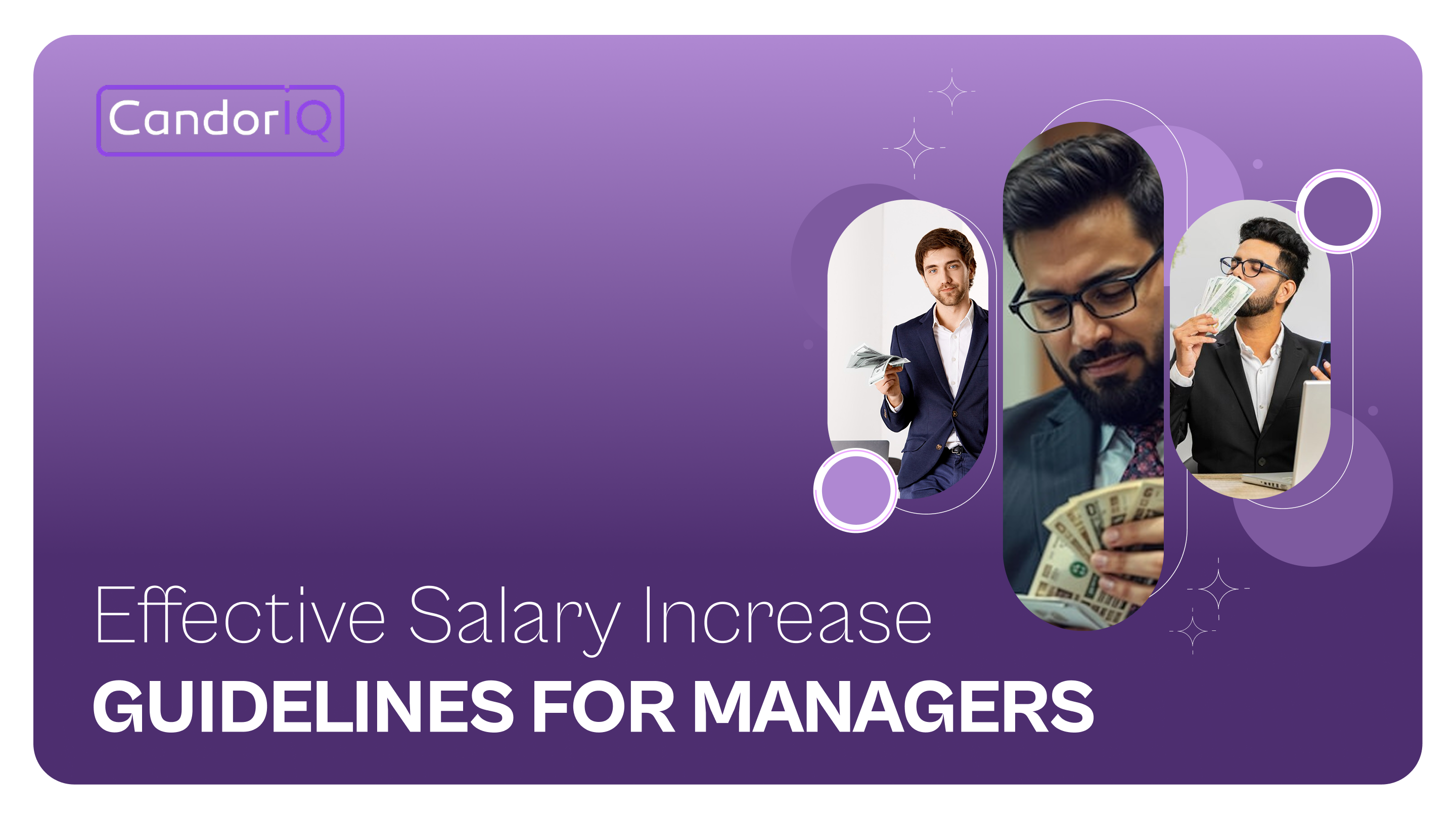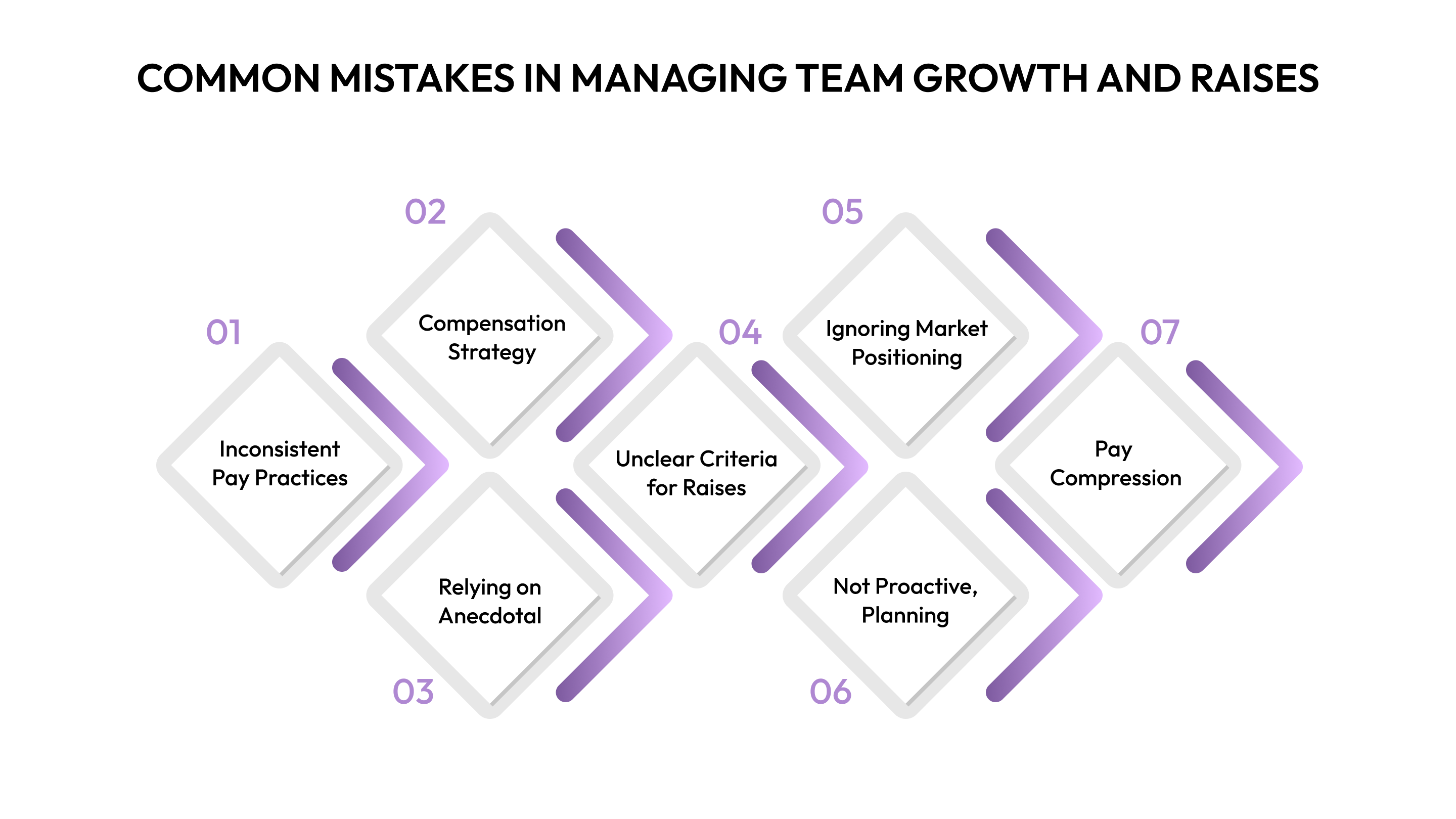Effective Salary Increase Guidelines for Managers
Master salary increase guidelines for managers. Balance requests, define clear criteria, leverage non-cash rewards. Ensure fairness and boost team motivation. Start implementing today!

Balancing employee expectations with company budgets is a struggle many managers face, particularly in growth-stage organizations where retaining talent is crucial. In fact, employees who feel they are unfairly compensated are 45% more likely to job-hop within six months, underscoring the power of perceived pay fairness in retention.
Yet, unclear or inconsistent raise practices can quickly erode trust and impact performance. Without clear salary guidelines, managers risk overspending, losing top talent, and creating inequitable pay outcomes.
In this blog, you’ll discover practical salary increase guidelines that will help you streamline compensation planning, maintain budget control, and foster a transparent, motivating pay culture.
At a glance
- Use salary grids based on roles, experience, and market benchmarks, and explain the rationale behind each increase to build trust and pay equity.
- Apply broad market adjustments for cost-of-living changes, while linking performance raises to measurable goals and business impact.
- Eliminate inconsistent pay practices, outdated market data, and reactive decisions that cause pay compression, budget issues, and talent loss.
- Analyze financial health, use up-to-date market data, and account for economic trends, while equipping managers with training and documentation.
- Monitor global pay competitiveness, address regional disparities, leverage compensation management tools, and balance short-term incentives with long-term rewards.
What is the Scope of Salary Increases and Its Role in Compensation Strategies

Salary increases are a key part of any effective compensation strategy, directly impacting employee motivation, retention, and overall company performance. Here’s how salary increases drive success:
- Attract and Retain Top Talent: Offering competitive salary increases helps you attract skilled professionals and keep your best performers, especially in competitive industries.
- Reward Performance: Salary increases reflect an employee's contributions and accomplishments, motivating them to maintain high performance and deliver strong results.
- Stay Competitive in the Market: Regularly adjusting salaries based on market trends ensures you remain attractive to talent, while maintaining fairness within your organization.
- Encourage Career Growth: Tying salary increases to career progression motivates employees to develop new skills, move up the ladder, and stay committed to your company.
- Boost Employee Motivation: When employees see their efforts being recognized through salary increases, their satisfaction and motivation to perform improve.
- Ensure Fairness and Compliance: Regular salary reviews help you stay compliant with labor laws and equal pay standards, minimizing the risk of discrimination claims.
- Maintain Financial Balance: Aligning salary increases with your company’s financial health ensures you reward employees appropriately without compromising your budget.
Now that you understand the strategic importance of salary increases, let's transform this knowledge into a concrete framework you can implement immediately.

Also Read: Total Compensation vs. Salary: A Complete Guide for Employees and Candidates
Effective Salary Increase Guidelines for Managers
Salary increases are a powerful tool for driving employee motivation, retention, and overall company growth, especially in mid-sized to fast-growing organizations. To make the most of them, managers must approach salary increases in a structured, transparent, and data-driven way.
Here are actionable guidelines to help you manage salary increases effectively, ensure fairness, and keep your teams motivated during periods of change.
Core Principles for Salary Increases
A successful salary increase strategy revolves around a few key principles that maintain fairness, transparency, and alignment with business goals:
- Set Clear, Objective Criteria: Use a salary grid based on job roles, experience, and market benchmarks. This ensures pay equity and compliance across the organization.
- Separate Collective and Individual Increases: Reserve collective increases for broad market adjustments (such as cost-of-living adjustments) and performance-based increases for individuals who show high impact or take on expanded responsibilities.
- Transparency Is Key: Make salary decisions transparent. Always explain the “why” behind each increase, tie it to business goals or individual employee contributions to create trust.
- Establish a Regular Review Cycle: Set a pre-defined, annual salary review cycle that aligns with performance reviews and budget cycles. This creates consistency and predictability.
Steps to Guide Effective Salary Raises
With these core principles as your foundation, here's how to put them into action through a systematic approach:
- Budget Setting: Before allocating salary increases, analyze your company’s financials, review industry benchmarks, and factor in inflation or cost-of-living changes. Align the salary increase pool with your strategic priorities.
- Define and Communicate Criteria: Be clear with your team on what behaviors, achievements, and metrics will lead to salary increases. This includes goal achievement, skill development, and overall impact on company objectives.
- Use SMART Goals: Tie salary increases to specific, measurable, achievable, realistic, and time-bound goals. This ensures that performance-based raises are fair and defensible.
- Train Your Managers: Provide managers with training on fair evaluation and unbiased decision-making. As your organization grows, this is especially important for ensuring consistency in how raises are granted.
- Document and Automate: Use HR software or compensation management tools to track salary increases. This ensures consistency, reduces errors, and supports transparency.
While these guidelines work well for traditional organizations, fast-growing companies with distributed teams face unique challenges that require specialized approaches.
Also Read: How to Build a Scalable Salary and Raise Structure for Growing Organizations?
Best Practices of Salary Increase for Fast-Growing Organizations with Distributed Workforces

As your organization rapidly scales, especially with a lean HR team and a globally distributed workforce, it’s critical to adopt best practices for managing salary increases that address the unique challenges of a decentralized team. Here’s how you can enhance your salary increase process:
- Monitor Pay Competitiveness Globally: Regularly benchmark your compensation packages against industry standards in each region where you operate. This helps you retain top talent in diverse and competitive markets. Tools like CandorIQ can assist in streamlining compensation benchmarking, ensuring your pay structures are competitive across global markets.
- Balance Short-Term and Long-Term Rewards: While salary increases are important, don't forget about one-time incentives or variable bonuses for short-term achievements, such as project completions or key milestones. These rewards can align employees with your immediate business goals and recognize their contributions on specific projects.
- Address Currency and Regional Pay Disparities: For distributed teams, ensure you're adjusting salaries to account for currency differences and varying costs of living in different regions. By taking into consideration local market conditions, you can offer fair compensation without unintentionally disadvantaging employees based on their location.
- Focus on Equity and Fairness Across Borders: Conduct regular audits of salary increases to ensure fairness across teams, roles, and demographics. This is especially important for a distributed workforce, where employees from different regions and backgrounds can sometimes face pay disparities. Ensuring pay equity helps build trust and strengthens your company's reputation as an employer of choice.
- Leverage Technology for Global Compensation Management: Use compensation management tools to track, adjust, and report salary increases. This becomes even more critical as your organization grows globally. With CandorIQ, you can simplify this process by integrating salary data across teams, automating workflows, and ensuring your compensation structure is both fair and competitive.
- Gather Feedback and Continuously Improve: After each salary cycle, seek feedback from both managers and employees. This feedback loop is essential for refining the salary increase process, improving employee satisfaction, and ensuring that your approach to pay is motivating, fair, and aligned with company goals.
Even with the best intentions and frameworks, many leaders stumble into predictable traps. Learning from these common missteps will save you time, money, and talent.
Common Mistakes in Managing Team Growth and Raises

As organizations grow, CPOs and CFOs often make several missteps when it comes to managing team growth and salary increases. These mistakes can lead to inequities, frustration, and even turnover. Here’s a breakdown of the most common mistakes:
- Inconsistent Pay Practices: Pay decisions that are made on a case-by-case basis, like reacting to competing offers or individual negotiations, often lead to internal pay inequities. Over time, this erodes trust, widens pay gaps, and contributes to higher turnover rates.
- Lack of a Compensation Strategy: Without a clear, documented compensation strategy, pay raises become unpredictable and misaligned with company goals. This can lead to budget strain, the loss of top talent, or, in some cases, overpaying employees who aren’t delivering.
- Relying on Anecdotal or Outdated Market Data: Using "Googled" or unverified market data for salary benchmarks can be risky. When CPOs or CFOs don’t invest in up-to-date, reliable compensation surveys, they risk overpaying or underpaying employees, leading to dissatisfaction and financial inefficiencies.
- Unclear Criteria for Raises: When performance-based criteria for salary increases are not transparent, it makes the process seem arbitrary and subjective. Employees may feel that raises are unfair, which can damage morale and contribute to retention issues.
- Ignoring Market Positioning in Raises: Equal percentage-based raises across the board, regardless of an employee’s starting salary, can perpetuate existing pay gaps. Salaries should first align with market rates before adjustments are made for performance or tenure.
- Reactive, Not Proactive, Planning: Reacting to pay issues only when employees threaten to leave or when there’s a budget crisis leads to rushed, costly fixes. Proactive planning is crucial for maintaining long-term budget discipline and employee satisfaction.
- Pay Compression and Hidden Inequities: If compensation isn’t regularly reviewed, junior or newer employees may end up earning as much or more than their more experienced counterparts. This pay compression can create dissatisfaction and resentment among longer-tenured staff.
Failing to address these issues can result in loss of key talent and higher turnover, erosion of employee trust and engagement. It will also create legal risks due to a lack of equity and transparency, and strained budgets and unsustainable growth for your company. Below are some tips to avoid these consequences.
Tips for Determining Budgets and Guiding Managers in Salary Increase Decisions

To avoid negative repercussions and make salary increase decisions more effective, here are some smart, actionable tips for determining budgets and guiding managers:
- Assess Financial Health and Plan for Scenarios: Analyze the company’s financial status, revenue, cash flow, and forecasts. Present multiple budget scenarios (minimum, ideal, maximum) to leadership, illustrating the impact on retention and strategic goals.
- Benchmark Regularly Against Market Data: Use up-to-date compensation tools to benchmark against real-time market data. Cross-check this with internal salary bands to stay competitive and fair, avoiding under- or over-budgeting.
- Account for Economic Trends: Factor in macroeconomic trends like inflation and cost-of-living when planning salary increases. This keeps your salaries competitive and shows understanding of employee needs.
- Leverage Historical Data for Insights: Review past salary changes and their impact on engagement, retention, and outcomes. Use this data to build targeted budgets that address key roles and high performers.
- Hold Calibration Sessions for Consistency: Regularly hold performance calibration meetings with HR, department heads, and senior leaders to ensure consistent, fair raises. This helps address pay equity, inflated ratings, and overlooked talent.
- Equip Managers with Tools and Training: Provide managers with training and standardized criteria for performance evaluations and pay decisions. This reduces bias and improves fairness.
- Require Documentation and Justification: Have managers document their pay recommendations, justifying them based on business impact and equity goals. This ensures transparency and alignment.
- Engage Employees in the Process: Involve employees in understanding the criteria for raises and offer feedback on performance expectations. This boosts engagement and ownership of their growth.
- Use Targeted Retention Strategies: Allocate part of the budget for non-cash rewards and growth opportunities, especially for key roles. Combining salary and non-salary incentives keeps talent motivated.
You now have a comprehensive roadmap for managing salary increases strategically.

Conclusion
Managing salary increases effectively requires strategic planning, clear criteria, and the right tools for consistent execution. Without proper systems in place, even well-intentioned managers risk creating pay inequities, budget overruns, and losing top talent. The key is balancing transparency with financial discipline while staying competitive.
CandorIQ makes this process easier by providing real-time market benchmarking, automated workflows, and equity tracking across distributed teams, eliminating the guesswork that leads to costly compensation mistakes.
Ready to optimize your salary increase process? Book a demo to identify gaps in your current approach and uncover actionable steps to build a fair, budget-conscious compensation strategy that keeps your best talent.
Frequently Asked Questions
Q: How often should we conduct salary reviews for our team members?
A: Conduct formal salary reviews annually, aligned with performance reviews and budget planning cycles. However, address significant role changes, promotions, or market shifts immediately rather than waiting for the annual cycle.
Q: What percentage of our total budget should we allocate to salary increases?
A: Most organizations allocate 3-5% of total payroll for annual salary increases, split between cost-of-living adjustments (1-3%) and performance-based increases (1-3%). Adjust based on your industry, growth stage, and retention needs.
Q: How do we handle salary increase requests outside of our regular review cycle?
A: Establish a clear policy requiring written justification for off-cycle requests, including market data, role expansion details, or retention risk factors. Limit approvals to significant role changes, counter-offers from competitors, or critical retention situations.
Q: Should we tell employees their salary increase percentage or just the new salary amount?
A: Share both the percentage increase and the new salary amount for transparency. Explain how the increase breaks down (market adjustment vs. performance-based) and provide context about your decision-making criteria to build trust and understanding.


